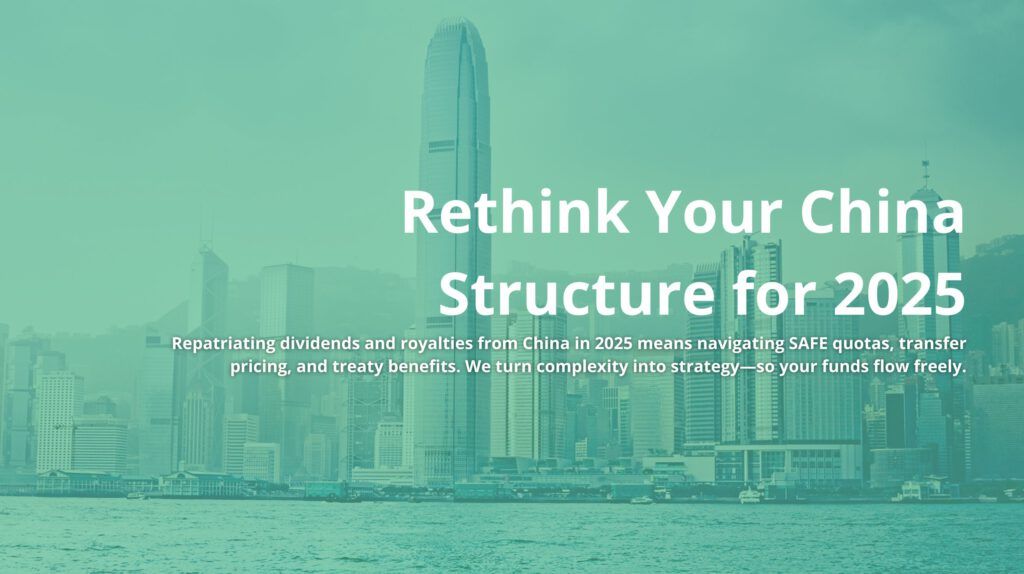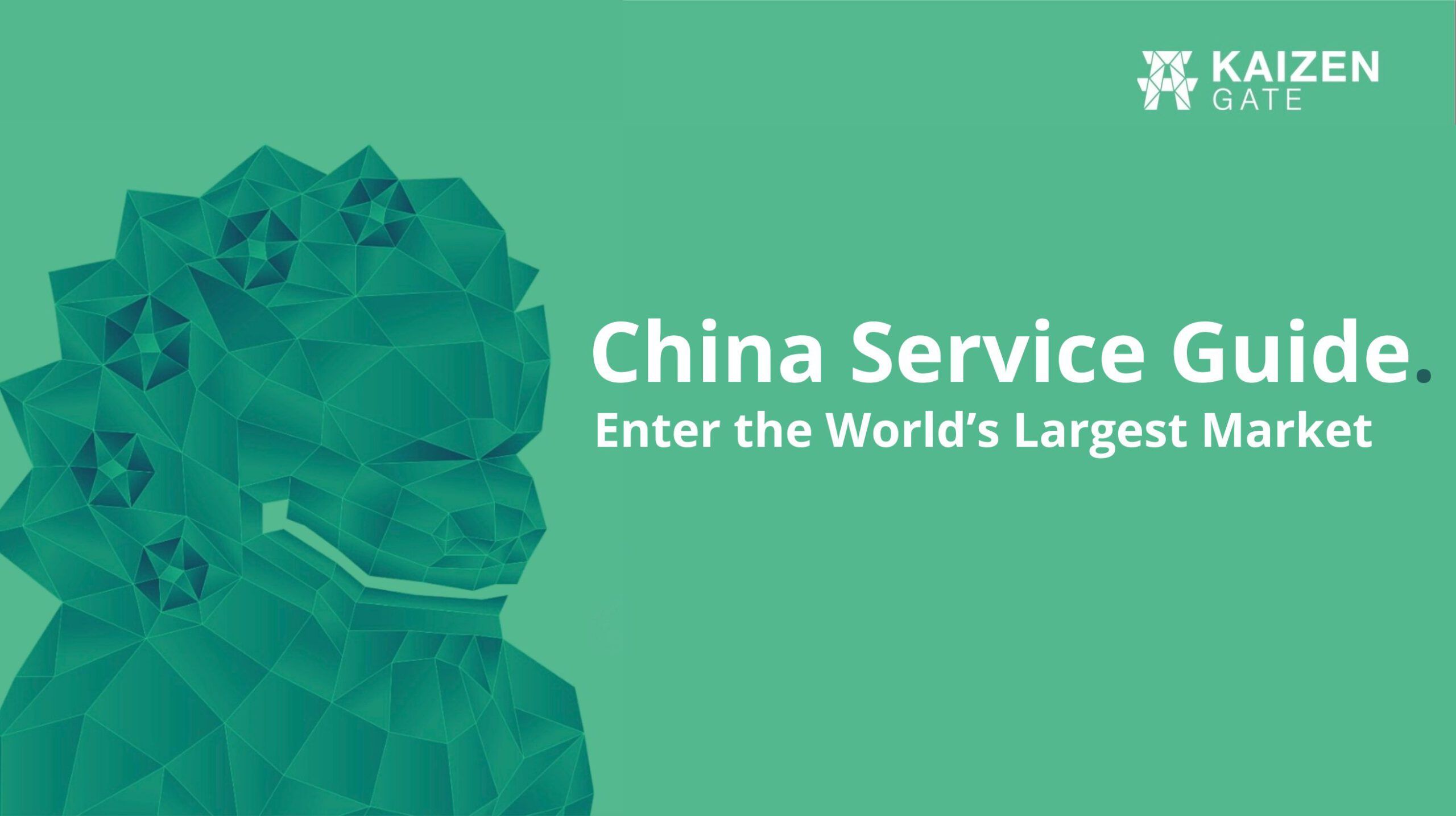Key Insights for CFOs and International Trade Professionals
Hong Kong has spent half a century serving as the world’s preferred gateway to mainland China. In the 1990s and early 2000s it was common for 70 percent or more of all “foreign‑invested” capital entering China to be routed through a Hong Kong company.
Over the last decade, however, the terrain has shifted. China now maintains double‑tax treaties with 114 jurisdictions, while capital‑control enforcement, transfer‑pricing scrutiny, and geopolitical risk have all tightened. These developments have triggered a strategic question for CFOs and international tax planners in 2025:
“Does it still make sense to keep or form a Hong Kong entity for China business, or are direct investment (a mainland WFOE) or an alternative hub such as Singapore the smarter play?”
The Traditional Value Proposition of Hong Kong
- Territorial Tax System. Profits tax is 16.5 percent, with a 50 percent concession (8.25 percent) on the first HK $2 million for qualifying SMEs. Foreign‑sourced dividends and capital gains remain outside the Hong Kong tax net, giving multinationals a natural low‑tax sink for regional cash.
- Rule‑of‑Law Environment. Hong Kong’s common‑law courts and independent judiciary provide stronger contract enforcement than most of Asia. Share transfers, capital reductions, and corporate authorizations can be completed in days, versus weeks or months on the mainland.
- Free Capital Movement. The Hong Kong dollar is fully convertible, and there are no withholding taxes on outbound dividends, interest, or royalties.
- CEPA Benefits. The Closer Economic Partnership Arrangement grants Hong Kong–incorporated firms earlier or easier access to dozens of mainland service sectors.
- Ease of Incorporation. A private company can be registered online within four working days, with no local‑director requirement and statutory capital as low as HK $1.
Taken together, these elements long made Hong Kong the archetypal hold‑co plus trading‑co platform for China‑facing groups.
What Has Changed?
Treaty Parity
Because China’s tax‑treaty network now covers nearly every major capital‑exporting country, the Hong Kong treaty is no longer uniquely advantageous. A German or Singaporean parent can generally obtain the same 5 percent dividend withholding rate directly under its own treaty, eliminating a key historic reason to interpose a Hong Kong entity.
Intensified Scrutiny on Intercompany Payments
China’s State Taxation Administration (STA) and State Administration of Foreign Exchange (SAFE) have spent the last five years deploying real‑time data sharing. Service and royalty fees to offshore affiliates must clear transfer‑pricing, tax, and forex tests before funds move, and banks will not process payments without the electronic tax receipt. The days of monthly “management‑fee sweeps” to Hong Kong are over; compliance lead times of 4–6 weeks are now typical.
Capital‑Control Friction
Dividends still flow, but only after the annual audit and tax clearance, the earliest is usually May of the following year. SAFE quotas cap the amount of related‑party debt a WFOE may service, while outbound shareholder loans from China to Hong Kong remain prohibited.
Regulatory & Market‑Access Limits
A Hong Kong company cannot issue VAT fapiao, open local e-commerce stores, register products with the State Administration of Market Regulation (SAMR), or hire mainland staff directly. In e‑commerce, major Chinese platforms now demand onshore seller entities and real‑time tax deduction at source, shrinking the scope for purely offshore trading plays.
Geopolitical Overlay
Since the National Security Law (2020), several Western governments, including the U.S., have warned investors to reassess legal‑risk exposure in Hong Kong. The territory’s special tariff status with the U.S. was revoked in 2022, meaning certain exports from Hong Kong now face the same customs duties as those from mainland China.

Scenarios Where a Hong Kong Entity Still Adds Value
Regional or Global Holding Company
A Hong Kong Holding that owns a China WFOE plus other Asian subsidiaries can still access the 5% dividend tax rate (instead of regular 10% WHT), as it shows real business substance by owning several entities globally. Once dividends reach Hong Kong, there’s no further tax, making it a strong base for reinvestment or IPO planning. Investors also prefer Hong Kong law for minority stakes, and share sales avoid China’s capital gains tax.
Cross‑Border Trading Hub
Where goods flow out of China to ASEAN, Europe, or the Americas, or into China via bulk procurement, Hong Kong’s zero tariff on re-exports and deep trade finance market can shave 2–5 percent off landed cost. This saving comes from a mix of lower tax on shifted profits, cheaper FX and banking, and smoother logistics. Example: a Shenzhen WFOE sells to its Hong Kong sister at cost + 8 percent, booking the bulk of profit in low tax Hong Kong, which then invoices global customers in USD.
Offshore IP and Treasury Center
Companies that own software code, trademarks, or patents outside China can license them to the WFOE from Hong Kong, beneficiating the royalties at Hong Kong’s 0 percent offshore rate while still qualifying for China’s 7 percent treaty withholding (versus 10 percent statutory). The Hong Kong vehicle can also act as the Asian treasury center, issuing internal loans to multiple subsidiaries and centralizing FX risk.
Dual‑Entity China Strategy
Many groups thrive on a “WFOE + HK” stack: the mainland unit focuses on domestic sales, fapiaos, and PRC compliance, while Hong Kong handles regional procurement and global contracting. Such dual structures ensure cost‑sharing, royalty rates, and debt‑to‑equity ratios stay within both STA guidance and OECD BEPS benchmarks, preventing double taxation or disallowed deductions.
When to Choose an Alternative Structure
- Pure Domestic Plays. If your revenue will be almost entirely inside mainland China, and especially if you must issue large volumes of fapiaos, go straight to a WFOE or JV. Adding Hong Kong offers little upside and introduces duplicate audits and G&A.
- Heavy Importer‑of‑Record Needs. High‑volume import businesses (e.g., cosmetics, medical devices) now clear customs faster, and at lower third‑party‑agent cost, through a bonded warehouse under their own WFOE than via Hong Kong transit.
- Global‑Minimum‑Tax Exposure. Large multinationals subject to OECD Pillar Two will pay a 15 percent top‑up on Hong Kong earnings anyway; the marginal tax saving versus Singapore’s 17 percent is negligible once compliance cost is added.
- Perceived Political Neutrality. Companies in sectors sensitive to U.S. export controls (semiconductors, dual‑use tech) may choose Singapore for regional headquarters to sidestep the optics of a Hong Kong domicile in procurement contracts with Western governments.
Repatriation and Tax‑Efficiency Toolkit (2025 Update)
| Method | China Taxes | Timing & Controls | Hong Kong Treatment | Key 2025 Tips |
| Dividends | 10 % WHT (5 % if HK hold‑co passes beneficial‑owner test) | Annual, post‑audit; SAFE registration required | Tax‑exempt | Keep HK company substance (board, bank a/c) to secure 5 % rate |
| Royalties / Service Fees | 6 % VAT + 10 % WHT (7 % treaty) | Can be monthly; bank checks tax receipts | Offshore income—0 % | Document services; align TP margins; SAFE reviews contract value |
| Interest on Shareholder Loans | 10 % WHT (may drop to 7 %) | Quarterly possible; loan quota ≤ 2× equity | 0 % | Register loan with SAFE; monitor thin‑cap ratio |
| Capital Reduction / Liquidation | Variable CIT on gain | One‑off; months to approve | 0 % on receipt | Use sparingly; high paperwork |
Executed properly, a blend of quarterly fees and an annual dividend still clears substantial cash into Hong Kong at a blended China tax cost near 8–10 percent, then zero in Hong Kong.

Strategic Considerations for 2025 – 2029
- Decoupling Risk Mitigation. Maintain optionality by pairing Hong Kong with at least one alternative Asian hub (often Singapore or Kuala Lumpur) for data redundancy and board meetings.
- ESG & Transparency. Hong Kong’s Significant Controllers Register, and automatic exchange‑of‑information regime mean shell entities without staff will not withstand OECD or investor scrutiny. Ensure Hong Kong operations have economic substance, real people or genuine IP functions.
- Greater Bay Area Synergy. Beijing’s policy maps increasingly treat Hong Kong, Shenzhen, and Guangzhou as one market. Companies leveraging R&D in Shenzhen plus financing in Hong Kong can capture both talent pools and capital liquidity.
- E‑CNY & Digital‑Finance Pilots. Pilot projects allow certain Hong Kong banks to settle trade invoices directly in digital RMB with mainland counterparts, potentially reducing SAFE friction by 2026. Early movers may gain treasury efficiency.
- Post‑2047 Outlook. With 22 years left on “One Country, Two Systems,” Beijing has strong incentives to keep Hong Kong attractive for debt and equity financing. However, boards should revisit entity‑risk matrices every 18 months as U.S.–China policy evolves.
Conclusion & Decision Framework
| Strategic Goal | Best‑Fit Structure in 2025 | Why |
| Hold China equity, raise Asia capital, plan potential HK listing | Hong Kong hold‑co + China WFOE | Treaty 5 % WHT, IPO venue, free capital outflows |
| High‑volume exports from China, global clientes pay USD/EUR | Shenzhen WFOE → HK trading‑co | Profit booked in 16.5 % (often 8.25 %) jurisdiction, robust trade finance |
| Pure domestic sales, need fapiao, local hires | Standalone WFOE / JV | Eliminates duplicate compliance, meets customer & tax requirements |
| Diversified Asia play with modest China share | Singapore HQ; optional HK branch | Pillar Two neutralizes HK tax edge; Singapore seen as geopolitically neutral |
| IP ownership, regional R&D, licensing to China + ASEAN | HK IP‑hold‑co + R&D center outside China | Royalty conduit at 0 % HK tax; STA still accepts 7 % treaty WHT if substance proven |
Bottom line: Hong Kong is no longer the automatic choice, but it remains an exceptionally powerful tool when matched to the right fact pattern.
Evaluate:
- Where value is created (China, ASEAN, global HQ).
- How cash must flow (dividends vs. royalties vs. debt).
- Stakeholder perception and ESG posture.
If Hong Kong materially lowers tax leakage and simplifies cross‑border capital movement without compromising compliance, it still deserves a place in your 2025 structure. Where objectives are primarily domestic‑China or globally diversified, a direct WFOE or a Singapore‑anchored model may now be superior. For most groups, the optimal answer involves scenario modelling rather than instinct.
Is your current structure aligned with your China strategy for the next five years? If the answer is “not sure,” the time to revisit the Hong Kong question, before the next dividend cycle closes, is now.

Gate Kaizen is the trusted partner of large and mid-cap companies as a provider of market entry services and HR Solutions in the Chinese market. We help your business save the outsantding costs of setting up your local entity by leveraging our own structure and the shortcuts of the digital era to minimize the financial risks of expanding overseas. This way, you can focus your attention on what really matters: your business.

